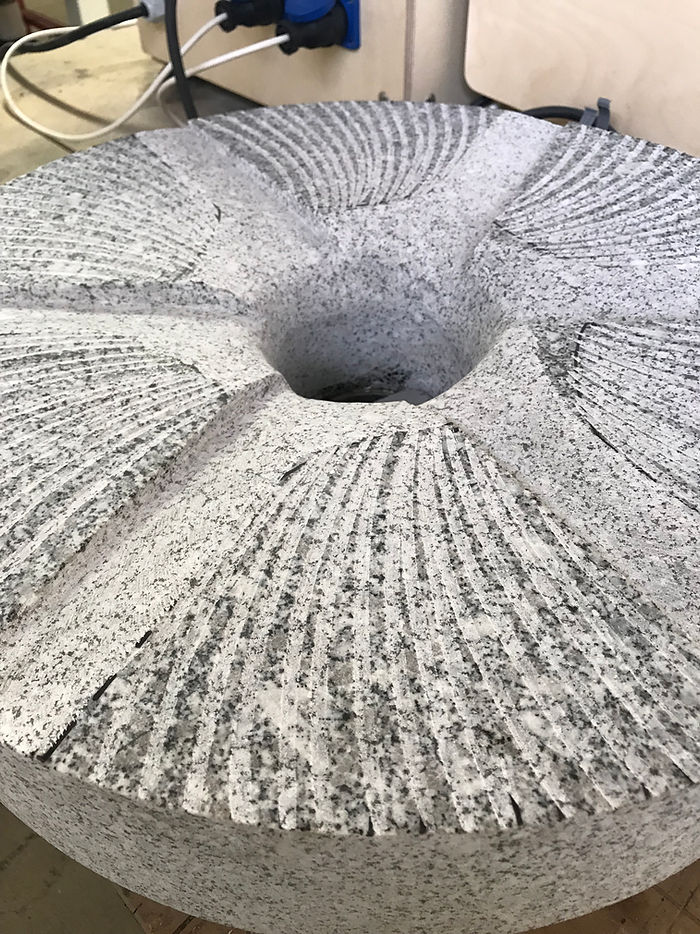
And the answers were unanimous: there aren’t a thousand and one ways to reinvent flour production, there’s just one: the Astrié mill.
But be careful! To choose the right Astrié mill manufacturer and be certain that it meets the criteria of the mills created by the Astrié brothers themselves, you need to pay particular attention to certain technical characteristics!
Criterion no. 1 for the Astrié mill: a stone millstone that doesn’t crush the flour
Of course, the great advantage of the Astrié mill is that it doesn’t turn cereals into flour like all the other mills.
In fact, it does not crush the grain. So how do you make flour if you don’t crush the grain? Well, quite simply by unrolling it.
And to do this, the mechanism is absolutely unique: the mill is made up of two millstones. The flying wheel turns on the stationary wheel. An oscillating system and a spring are used to trigger the rotation of the rotating wheel without its weight crushing the grain.

The seed is first placed in the hopper and then distributed by a special mechanism between the two millstones, where it is completely unrolled.
The gap between the wheels: the work of a goldsmith
It’s a clever combination of two springs that control the upward force exerted by the grinder and precisely regulate the gap between the two millstones. What makes the Astrié mill so unique is the precise, millimetric control of the gap between the two millstones.

It’s this micrometric adjustment, combined with the grinding of the working surfaces (instead of the usual pitting offered by conventional mills), that gives you the opportunity not to break the bran, but to separate it from the flour. This allows you to obtain graded flour in a single pass, free of the less easily digestible bran. And whether you’re used to using conventional cylinders or old mills, this result is unattainable.
Carefully selected stones
But this very special mechanism is obviously not possible on mills that use the wrong stone. Old stone mills are made from stones that are too soft, or so-called millstones, which need to be joined together with steel to work properly.
But Astrié millstones are designed and cut from stones that are strong and efficient enough to hold the grain and unwind it completely, without crushing it.

It’s the granite from Sidobre (Tarn), which, when cut to a very precise shape by mill manufacturer Astrié, will give it unique durability and reliability.
So keep an eye out when buying your mill: if the millstones aren’t made from Sidobre granite, it’s impossible to process the grain properly and produce flour of the same quality as that from the Astrié mill!
Criterion no. 2 for mill manufacturer Astrié: slow rotation speed
Once again, be careful when you buy your Astrié mill. The size of the rotating wheel and its weight allow a slow rotation speed, which makes it possible to preserve all the nutritional properties of the flour.
The higher the speed of rotation, the more the cereal heats up, oxidises and loses its nutritional qualities. The Astrié mill manufacturer will therefore take care to respect its technical specifications.
Criterion no. 3 for mill manufacturer Astrié: the sieve
Finally, in designing an Astrié mill, it is essential to note that the sieving of the milling output has also been the subject of ingenious research. In fact, the primary objective of the Astrié mill’s sieve is to remove the constraints of the milling process, which can sometimes lead to condensation in the sieving chamber, resulting in poor sieving. In old stone mills, this problem is an obstacle to the production of quality flour. At the Astrié mill, every detail is important. And it’s the coherence of the whole (from the mill, to the millstones, to the springs and sifting management) that makes it a simple, efficient and coherent mill.


To be sure you’re making the right choice when buying your Astrié mill, there are a number of points to consider. First of all, look at the quality and size of the grinding wheels, the possible adjustment of the gap between the wheels, and the stone used to make them. Finally, pay attention to the speed of rotation, which should not cause the grain to overheat, so that you can produce quality flour with exceptional nutritional properties. A good Astrié mill maker knows all these technical details inside out, so don’t hesitate to ask!

